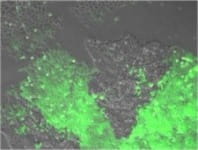A new technique for maintaining cancer stem cells in the lab may prove to be the key to stopping them in the body, according to scientists at the John G. Rangos Sr. Research Center at UPMC Children’s Hospital of Pittsburgh and the University of Pittsburgh School of Medicine.
The breakthrough allows researchers to grow virtually unlimited numbers of cancer cells, enabling them to observe, analyze, and test various drug therapies, which may ultimately escalate the development of new and better treatments.
 Cancer stem cells (green) illuminated with ultraviolet light shown with their non-stem cell counterparts. With the stem cells in their “frozen” state, the two populations segregate, providing scientists at the John G. Rangos Sr. Research Center with raw material for experimentation.
Cancer stem cells (green) illuminated with ultraviolet light shown with their non-stem cell counterparts. With the stem cells in their “frozen” state, the two populations segregate, providing scientists at the John G. Rangos Sr. Research Center with raw material for experimentation.
The study team was led by Edward Prochownik, MD, PhD, director of Oncology Research at Children’s Hospital and the Paul C. Gaffney Professor of Pediatrics and of Molecular Genetics and Biochemistry at the University of Pittsburgh School of Medicine.
The study focused on four different lines of breast cancer stem cells and identified a method of permanently “blocking” them so they remain stem cells instead of differentiating into other types of tumor-forming cells. Until now, obtaining cancer stem cells in sufficient quantities and maintaining their undifferentiated state have been major hurdles to identification of drugs that target these cells.
Although they make up a relatively small portion of a tumor, cancer stem cells are important because scientists believe they initiate and sustain tumors as they grow and metastasize. They are also heartier than other types of tumor cells because they are generally more resistant to standard chemotherapy and to conditions found inside tumors, such as low oxygen and acidity levels.
Somewhat elusive to researchers, cancer stem cells differentiate into other cells within three to five weeks of being isolated, making them difficult to study, according to Dr. Prochownik. He and his colleagues at the John G. Rangos Sr. Research Center at Children’s Hospital were able to tag the breast cancer stem cells they isolated with green fluorescent protein and a stem cell-specific promoter know as Oct-3/4.
“Using this approach, we can essentially ‘freeze’ the stem cells in their current state, grow them in unlimited quantities and then study them more thoroughly than before, so we’ll be able to understand what makes cancer stem cells more efficient than other types of cancer cells,” said Dr. Prochownik.
“More importantly, having this unlimited supply of cancer stem cells allows us to use existing technology to screen them for chemotherapy agents and other therapies to determine which therapies are most effective at targeting and destroying the cancer stem cells,” he continued. “The goal is an arsenal of therapies to target both the tumor as a whole as well as those specific to the cancer stem cells.”
Dr. Prochownik’s team at the Rangos Research Center is now studying whether their method of blocking breast cancer stem cells also blocks those from other types of tumors. They also are screening large numbers of drugs to identify new ones that may be more effective against breast cancer stem cells.
A renowned researcher, Dr. Prochownik was one of the first recipients of Children’s Hospital’s Innovation Awards in 2007. Other study authors include: Gangadharan B. Sajithlal, PhD, and Kristi Rothermund, PhD, Children’s Hospital; Fang Zhang, PhD, University of Pittsburgh School of Medicine; David J. Dabbs, PhD, Magee-Womens Hospital of UPMC; and Jean J. Lattimer, PhD, and Stephen G. Grant, PhD, University of Pittsburgh Cancer Institute and University of Pittsburgh School of Medicine. The findings of their study were published in the journal Stem Cells.









 Cancer stem cells (green) illuminated with ultraviolet light shown with their non-stem cell counterparts. With the stem cells in their “frozen” state, the two populations segregate, providing scientists at the John G. Rangos Sr. Research Center with raw material for experimentation.
Cancer stem cells (green) illuminated with ultraviolet light shown with their non-stem cell counterparts. With the stem cells in their “frozen” state, the two populations segregate, providing scientists at the John G. Rangos Sr. Research Center with raw material for experimentation.